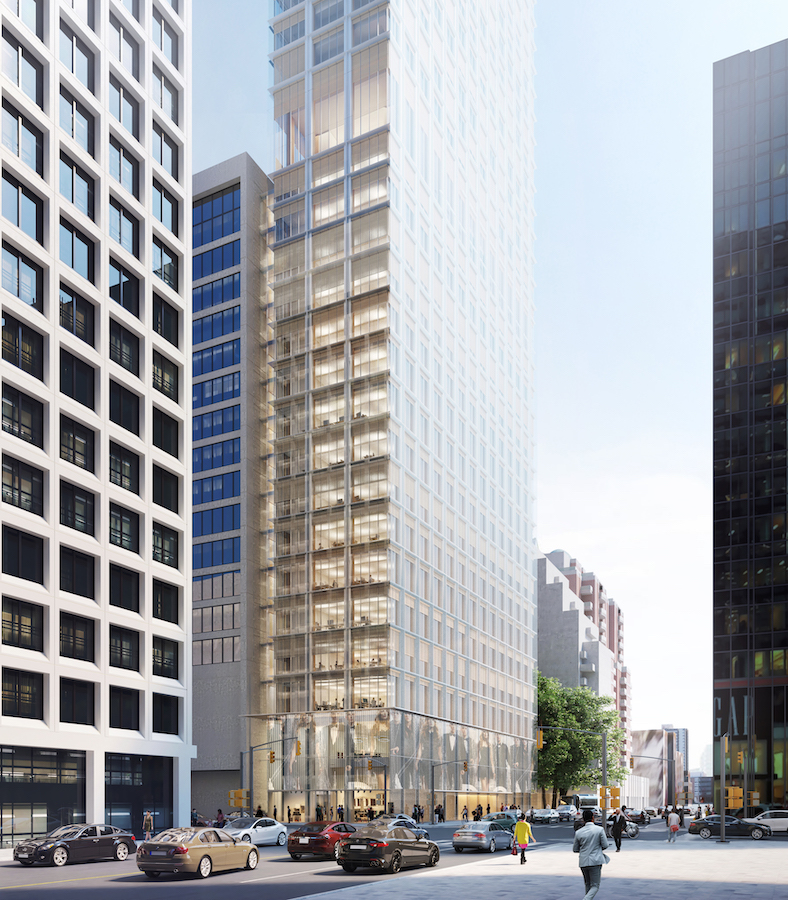Pritzker Prize winners Herzog & de Meuron (HdM) have designed a mixed-use tower for Toronto that would be among the tallest buildings on the continent.
On Wednesday, June 3, Dutch real estate companies ProWinko and Kroonenberg Groep announced their plans for the project, located on the edge of downtown, in the upscale Yorkville neighborhood.

Designed by HdM with local architects Quadrangle, the tower, called 1200 Bay, would occupy the site of a 12-story office building at the corner of Bloor and Bay Streets, atop a subway station. The tower’s massing and architectural expression are simple. Its rectangular podium would contain two floors of retail and 13 floors of office; above, a narrower tower of about 7,300 square feet rises straight up for 71 floors of residential space, capped with a restaurant. “The tower defines the northern edge of the downtown area and provides a landmark in the urban grid,” said HdM partner in charge Wim Walschap. “It is a very direct response to the site and the city around it.”
For the facades, HdM and Quadrangle propose a double skin: operable windows covered by adjustable wooden shutters that provide shading and allow fresh air inside, with an exterior layer of glazing. This skin would extend across both the office and residential floors, so that the visual language of the building would remain consistent, but also reflect the activity inside. “It’s about fresh air and healthy living,” said Heather Rolleston, a Quadrangle partner, with louvers that “allow the residents to shade their units any way they want.”

At its proposed height of 1,062 feet, the tower would be among the 15 tallest buildings in North America. Its narrow upper floor plate of 7,300 square feet recalls the “pencil towers” that Midtown Manhattan has seen in the past decade, but it would be taller than One57 by Christian de Portzamparc. There are few precedents in Toronto. A nearby tower by Foster & Partners now under construction, marketed as The One, is planned to rise almost as tall but has a floor plate of roughly 9,000 square feet. A proposed tower by Frank Gehry would rise to 1,079 feet; it has approvals but has not begun marketing.
However, Toronto is seeing significant high-rise construction. The city of nearly three million, in a region of six million, has experienced a 20-year construction boom, fed by domestic and international migration and the strength of the local financial and tech sectors. And while the region has been hit by COVID-19—upwards of 500 people have died in the city, and more in the suburbs—the real estate market remains strong. Despite the pandemic, more than 9 million square feet of office is still under construction, heavily concentrated in Toronto’s downtown.
The project has just been submitted for approvals, a process that will take at least two to three years. The architects say they are willing to integrate the building’s underground levels and servicing with another tall building being proposed next door to the west, which would rise to 79 stories.
This would allow the ground plane between the buildings and an adjacent laneway to be fully pedestrianized, linking up to a future park site, which would require the demolition of a city-owned office building—something that is under consideration by city officials as the city looks at doubling the population in its downtown area from roughly 250,000 to 475,000.



Post a comment to this article
Report Abusive Comment